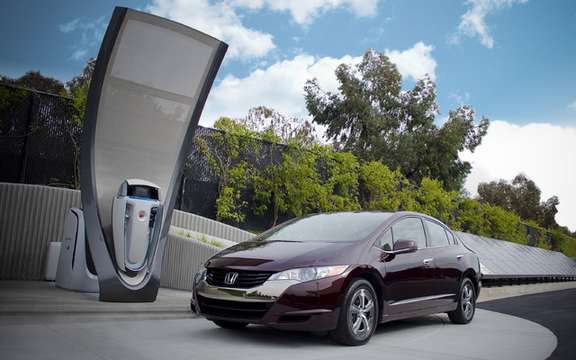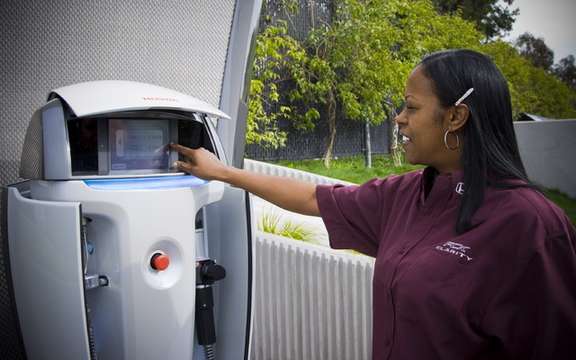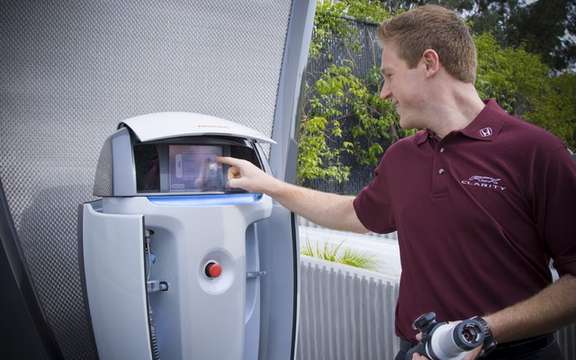Honda recently operated a service station solar hydrogen
Located in Los Angeles, the device is intended to supply the electric vehicles a fuel cell Honda
Honda has put into operation today a new experimental station for the production of hydrogen from solar energy at the site of Honda R & D Americas, Inc. in Los Angeles. This next generation unit is designed to be used, ultimately, as a domestic service station for refueling vehicles electric night of a fuel cell.
More compact than the previous generation and presented as a single integrated unit can be housed in the garage of a house, the new unit of Honda product, using solar panels, enough hydrogen (0, 5 kg) over a period of 8 hours night to feed commuting (16,000 km per year) for a fuel cell vehicle has.
The previous system was composed of two units: an electrolytic generator and a compressor unit to produce high-pressure hydrogen from solar energy. This compressor element of the larger and more expensive system, reduce accordingly the performance of the system. By creating a new type of electrolytic generator high pressure differential, the Honda engineers have managed to completely eliminate the compressor - a first for a domestic system. This innovation, which has also helped to reduce the size of other key components, makes the new station the world's most compact system while improving performance by more than 25% (calculated based on simulations) by relative to the solar hydrogen generation from the previous station.
Compatible with electric "Smart Grid" installation, service station Solar Hydrogen Station Honda allow users to refuel overnight while eliminating the need for hydrogen storage, which would reduce the emissions of CO (2) and would produce savings by reducing the electricity consumption to off-peak hours. During daytime peak periods, the station Solar Hydrogen Station can export to the electricity network of renewable, offering consumers the benefits relative to cost and remaining neutral energy.
Easy to use and user friendly, intuitive system allows the user to easily lift and remove the fuel hose that is not twisted when it is returned to the dispensing station.
Designed for a slow filling of eight destiny refueling overnight electric vehicle has a fuel cell, domestic service station Solar Hydrogen Station would be full of hydrogen for a typical daily commute, thus satisfying the needs of Many drivers. As with its predecessor, the hydrogen produced by the new station meets the SAE (J2719) and ISO (14687) the most stringent in matters of purity.
Installed on the site of Honda R & D Americas in Los Angeles, the new station Solar Hydrogen Station relies on the same solar generator consists of 48 modules with an output of 6.0 kW fed the previous system. The generator is manufactured from photovoltaic cells CIGS (copper, indium, gallium and selenium) produced by Honda Soltec Co., Inc., a wholly owned subsidiary of Honda established to manufacture and sell the individual solar panels can profitable way to produce renewable electrical energy. The manufacture of photovoltaic cells original Honda produces less emission of CO (2) than conventional cells.
Aimed at meeting the needs of future electric vehicle owners a fuel cell, the station Solar Hydrogen Station Honda is also designed to complement a public network of service stations rapid refueling hydrogen. FCX Clarity, Honda's electric car can be refueled quickly filling positions and offers a range of about 400 km. With public service stations or she would supply 5 minutes for long journeys, and the possibility of full rebuild slowly overnight at home using a solar station connected to the network "Smart Grid", the Honda FCX Clarity can respond to a wide range of needs of drivers, the daily commute to get to work until displacements weekend.
The creation of a station solar domestic production of hydrogen was primarily the establishment of a new lifestyle based on a practical household supplies, clean, energy efficient and sustainable, and answering the need for refueling infrastructure likely to promote the use of large-scale fuel cell vehicles has.
The combination of an electric vehicle a fuel cell and a gas station for producing hydrogen from solar energy is to stimulate the creation of a user company Hydrogen, renewable energy, resulting in a significant reduction of emissions of CO (2) and increased sustainability in terms of energy.
The operation of the first service station Solar Hydrogen Station in the center of Honda R & D Americas in Los Angeles dates back to 2001:
- July 2001: the operation of a system composed of 3 units and fitted with a device for hydrogen storage;
- October 2003: new system increased performance consists of 2 units, including an exclusive electrolytic generator, with a new network using solar photovoltaic cells CIGS experimental Honda;
- August 2008: The solar generator is equipped with CIGS cells produced by Honda Soltec Co. in series, thus reducing its size by 20% and improves further its photovoltaic performance;
- January 2010: the operation of an integrated new service station, with the best performance in the world
- yield increase of over 25% (calculated based on simulations) compared to the solar hydrogen generation from the previous station, which is the most high yield in the world for this type of systems.
Honda R & D Americas, Inc. (HRA) is responsible for the establishment in North America technology and advanced products offering a supplement value to consumers of Honda and Acura. HRA began its activities in research and development in 1975 by market research in California, and gradually increases its capabilities over the past 35 years to finally include all aspects of the design and development of new vehicles and to take a leadership role in the progress of technology in matters of safety and environmental protection.
Today, Honda operates 15 major research and development centers in North America, where more than 1,300 designers, engineers and employees support apply to the development of cars and trucks, motorcycles and electrical equipment intended to North American and global. steps
View the gallery










